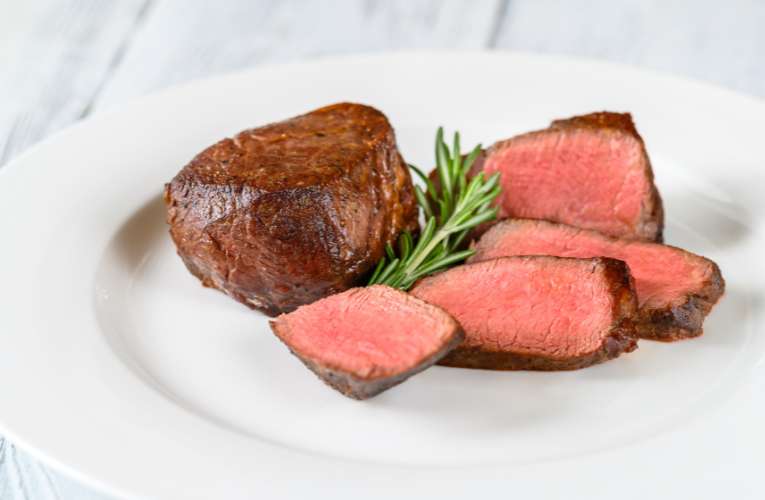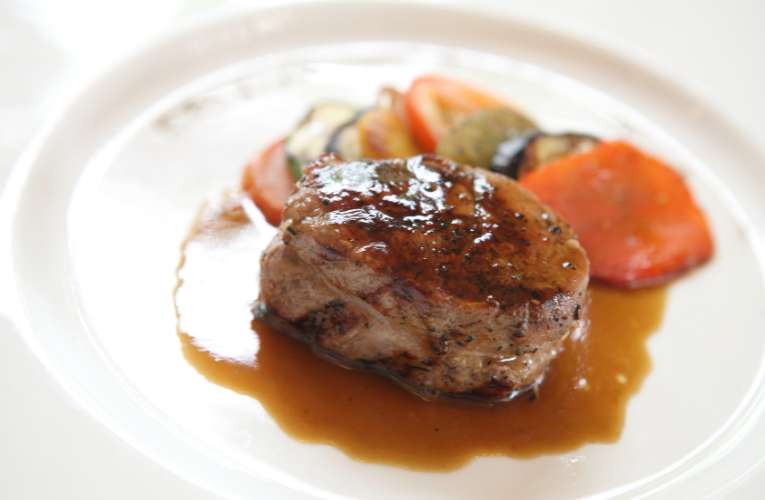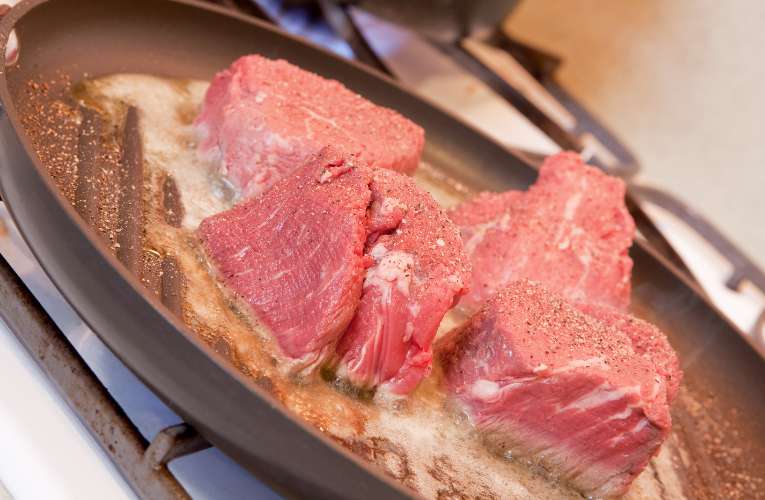Welcome to the world of filet mignon, the undisputed king of steaks. This article aims to celebrate the tender and luxurious qualities of filet mignon, providing you with a comprehensive understanding of this prized cut of beef.
From its melt-in-your-mouth texture to the best methods to cook it, we’ll delve into the fascinating world of filet mignon.
Additionally, we’ll explore flavor pairings and sauces that perfectly complement this cut, and share interesting facts about filet mignon to expand your culinary knowledge.
The Unparalleled Texture of Filet Mignon
When it comes to texture, filet mignon reigns supreme. This exquisite cut is renowned for its melt-in-your-mouth tenderness, making it a favorite among steak enthusiasts. The secret lies in the unique characteristics of the meat itself.
Filet mignon comes from the tenderloin, a muscle located beneath the backbone of the animal. This muscle group is rarely used, resulting in a remarkably tender and lean piece of meat.
The fine-grained texture and minimal connective tissue contribute to its delicate mouthfeel, allowing each bite to practically dissolve on your tongue.
Moreover, the marbling of fat within the meat adds a touch of richness and flavor without compromising its tenderness. The perfect balance of lean meat and intramuscular fat sets filet mignon apart from other cuts, ensuring an unparalleled dining experience.

Cooking Filet Mignon to Perfection
To fully appreciate the exceptional qualities of filet mignon, it’s crucial to master the art of cooking it to perfection. While there are various methods to cook this prized cut, the following techniques are particularly popular:
Grilling
Grilling filet mignon over high heat provides a beautiful sear on the outside while maintaining its tender interior. Preheat the grill to medium-high and lightly oil the grates to prevent sticking. Season the steak with salt, pepper, and any desired herbs or spices.
Place the filet mignon on the grill and cook for approximately 4-5 minutes per side for medium-rare doneness, adjusting the time according to your preferred level of doneness.
Pan-Searing
Pan-searing is an excellent option when you don’t have access to a grill. Start by preheating a heavy skillet over high heat. Season the filet mignon with salt and pepper, then add a high smoke-point oil (such as canola or grapeseed oil) to the skillet.
Carefully place the steak in the hot pan and sear for about 3-4 minutes on each side. For a medium-rare filet mignon, aim for an internal temperature of 130-135°F (54-57°C).
Broiling
Broiling is a convenient method that delivers excellent results. Start by preheating the broiler and positioning the oven rack about 4-6 inches below the heat source.
Season the filet mignon with your preferred seasonings, place it on a broiler pan, and position it under the broiler. Cook for approximately 5-6 minutes per side, adjusting the time based on your desired level of doneness.
Regardless of the cooking method you choose, it’s essential to let the filet mignon rest after cooking. This allows the juices to redistribute within the meat, resulting in a more flavorful and succulent steak. Simply tent the steak loosely with aluminum foil and let it rest for 5-10 minutes before serving.
Flavor Pairings and Sauces to Enhance Filet Mignon
While filet mignon possesses its own exceptional flavor, there are several flavor pairings and sauces that can elevate the taste even further. These complementary additions harmonize with the natural richness of the meat, creating a culinary masterpiece. Consider the following options:
Complementary Flavors
To enhance the flavor profile of filet mignon, pair it with ingredients that complement its richness. Mushrooms, such as cremini or shiitake, add an earthy depth, while caramelized onions provide a touch of sweetness.
Blue cheese crumbles offer a tangy contrast, and a drizzle of balsamic reduction can add a delightful sweetness and acidity to each bite.
Seasonings and Spices
When it comes to seasoning filet mignon, simplicity is key. A generous sprinkling of kosher salt and freshly ground black pepper is often enough to enhance the natural flavors of the meat.
However, you can experiment with additional herbs and spices such as rosemary, thyme, garlic powder, or even a hint of smoked paprika for a subtle twist.
Sauce Selection
A well-chosen sauce can take filet mignon to new heights of flavor. Classic options like béarnaise sauce, a creamy and tangy blend of egg yolks, butter, and tarragon, are a luxurious pairing.
A rich red wine reduction or a decadent peppercorn sauce can also beautifully complement the tender meat. For a lighter touch, consider a vibrant chimichurri sauce or a zesty horseradish cream.
Filet Mignon Facts and Variations
Now that we have explored the exceptional qualities of filet mignon and the best methods to cook it, let’s delve into some intriguing facts and variations of this prized cut.
Historical Significance
Filet mignon has a rich history and has long been associated with luxury and indulgence. The term “filet mignon” is derived from the French language, where “filet” means “thick slice” and “mignon” translates to “dainty” or “cute.”
It gained popularity in the United States during the late 19th and early 20th centuries and quickly became a symbol of fine dining and upscale cuisine.
Different Names and Cuts
While filet mignon is commonly referred to as such, it goes by different names in various parts of the world. In France, it is known as “filet de bœuf,” while in Italy, it is called “filetto di manzo.”
Additionally, the filet mignon is a section of the larger tenderloin cut, which also includes the Chateaubriand and Tournedos. The Chateaubriand is a thicker cut from the center of the tenderloin, while Tournedos are smaller medallions often wrapped in bacon.
Comparisons to Other Cuts
Filet mignon stands out among other popular cuts of beef due to its unique texture and tenderness.
While cuts like ribeye and New York strip steak offer more pronounced marbling and intense flavors, filet mignon is unrivaled in terms of its melt-in-your-mouth tenderness. It is the perfect choice for those who prefer a leaner and more delicate steak experience.

Filet Mignon: A Versatile Culinary Delight
Beyond its reputation as a standalone steak, filet mignon can be a versatile ingredient in various culinary creations. Let’s explore some exciting ways to incorporate this exquisite cut into your dishes.
Salads and Sandwiches
Thinly sliced filet mignon can be a luxurious addition to salads and sandwiches. Toss it with fresh greens, roasted vegetables, and a tangy vinaigrette for a gourmet salad.
Alternatively, layer it on a crusty baguette with arugula, caramelized onions, and a horseradish spread for an indulgent steak sandwich.
Pairing with Side Dishes
When serving filet mignon as a main course, consider pairing it with complementary side dishes. Creamy mashed potatoes, roasted root vegetables, or sautéed asparagus spears make excellent accompaniments.
You can also elevate your meal by serving it with a velvety truffle risotto or a refreshing citrus-infused quinoa salad.
Exploring Culinary Cuisines
Filet mignon is not limited to traditional Western cuisine. It can be incorporated into a variety of culinary styles, providing a delightful fusion of flavors.
Thinly sliced filet mignon can be stir-fried with Asian vegetables and soy-based sauces for an East-meets-West dish. Alternatively, marinate the steak in spices and yogurt for an Indian-inspired kebab, or sear it with chimichurri sauce for a South American twist.

Conclusion
Filet mignon, the king of steaks, captivates with its melt-in-your-mouth tenderness and luxurious texture. Understanding the best cooking methods, flavor pairings, and its historical significance enhances the dining experience.
From its rich history to its versatility in various cuisines, filet mignon continues to hold its reign as a culinary delight.
So, whether you choose to grill it to perfection, pair it with complementary flavors and sauces, or explore its versatility in different dishes, filet mignon promises an unforgettable dining experience.
Indulge in this prized cut, celebrate its unique qualities, and savor every moment as you embark on a gastronomic journey fit for royalty.
1. What is the ideal level of doneness for filet mignon?
The ideal level of doneness for filet mignon depends on personal preference. However, due to its tenderness, many people prefer to cook filet mignon to medium-rare or medium.
For medium-rare, aim for an internal temperature of 130-135°F (54-57°C), while medium would be around 140-145°F (60-63°C). It’s important to use a meat thermometer to ensure accurate results.
2. Can filet mignon be cooked well-done?
While filet mignon can be cooked well-done, it’s important to note that the longer cooking time required for well-done results may compromise its tenderness. The longer the meat cooks, the more it may dry out, resulting in a less juicy texture.
If you prefer your steak well-done, it is recommended to marinate it beforehand or consider alternative cuts that are better suited for longer cooking times.
3. How should I season filet mignon for the best flavor?
To enhance the natural flavors of filet mignon, a simple seasoning of kosher salt and freshly ground black pepper is often sufficient. However, you can experiment with additional herbs and spices to suit your taste.
Popular options include rosemary, thyme, garlic powder, or even a hint of smoked paprika. Remember to season the steak just before cooking to avoid drawing out excess moisture.
4. What are some common mistakes to avoid when cooking filet mignon?
One common mistake when cooking filet mignon is overcooking it, which can result in a dry and less tender steak. To prevent this, monitor the internal temperature carefully using a meat thermometer and remove the steak from the heat when it reaches your desired level of doneness.
Another mistake is skipping the resting period after cooking, as this step allows the juices to redistribute and ensures a more flavorful and juicy steak.
5. Are there any health considerations when consuming filet mignon?
Filet mignon is a lean cut of beef, which means it is relatively low in fat compared to other cuts. However, it is still important to consume it in moderation as part of a balanced diet.
If you have specific dietary restrictions or concerns, it is advisable to consult with a healthcare professional or nutritionist.
6. Can filet mignon be cooked using sous vide?
Yes, filet mignon can be cooked using the sous vide method. Sous vide involves vacuum-sealing the steak in a bag and cooking it in a water bath at a precise temperature for an extended period.
This method ensures even cooking and results in a tender and consistent texture throughout the steak. After sous vide cooking, you can quickly sear the filet mignon in a hot skillet or on a grill to achieve a flavorful crust.
7. How should I store filet mignon if I don’t plan to cook it immediately?
If you don’t plan to cook filet mignon immediately, it is best to store it in the refrigerator to maintain its freshness. Wrap the steak tightly in plastic wrap or place it in an airtight container to prevent air exposure.
Filet mignon can typically be refrigerated for up to 3-4 days. If you need to store it for longer, consider freezing it in a freezer-safe bag for up to 3-4 months.
8. Can filet mignon be cooked on a charcoal grill?
Absolutely! Cooking filet mignon on a charcoal grill can add a smoky and charred flavor to the steak. To do so, prepare your charcoal grill by lighting the charcoal and allowing it to heat until it reaches a medium-high temperature.
Place the filet mignon directly on the grill grates and cook according to your desired level of doneness, flipping it once halfway through the cooking process. Remember to monitor the internal temperature with a meat thermometer to ensure your preferred doneness is achieved.

